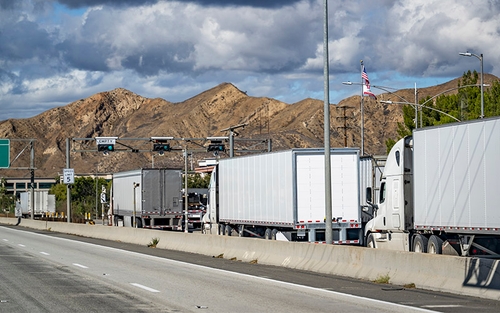Estimated reading time: 2 minutes
When it comes to the many rules and regulations truck drivers follow, a question one may have is, "Can semi-trucks drive in the left lane?"
Below, we’ll go over left lane regulations for truck drivers, how they vary by state and how drivers can follow them to stay safe and compliant on the road.
Can semi-trucks drive in the left lane?
In general, semi-trucks should avoid driving in the left lane unless necessary. The left lane is typically reserved for passing and faster-moving traffic. This is meant to improve traffic flow and reduce congestion on highways.
Almost all states have some restriction(s) for left lane use. Understanding these regulations is crucial for truck drivers to avoid fines and keep the roads safe.
When are semi-trucks allowed in the left lane?
Since semi-trucks often travel at slower speeds than passenger vehicles, their presence in the left lane can disrupt the flow of traffic. Because of this, general guidance is that semi-trucks should only use the left lane while:
- Overtaking another vehicle.
- Making a left turn.
- Exiting to the left.
- Avoiding hazards.
- Being directed around construction.
- Yielding to emergency vehicles.
When driving in the left lane not under these circumstances, drivers risk getting a lane restriction violation. It should also be noted that some states restrict left lane use to passing vehicles only. If a driver is in the left lane but not overtaking other vehicles, they risk getting a ticket, regardless of their speed.
What is a lane restriction violation?
A lane restriction violation goes on a driver’s record and may impact job opportunities. Getting a lane restriction violation also impacts the CSA score of the carrier they drive for. Lane restriction violations are a 3-point CSA violation.
Do lane violations differ from state to state?
Yes, the extent of left lane regulations varies from state to state. Because of this, drivers must check the regulations for each state they drive through.
While many states don’t have specific regulations about semi-trucks being in the left lane, all states have general left lane usage rules. Most states’ laws say that all vehicles must drive in the right-hand lane if driving slower than the flow of traffic. That said, some states have regulations that single out 18-wheelers and other large commercial vehicles.
For example, Pennsylvania’s regulations state that, "unless otherwise posted, no vehicle or combination over 10,000 pounds may be driven in the left-hand lane of a limited access highway having three or more lanes for traffic moving in the same direction except when preparing for a left turn at an intersection, an exit or into a private road or driveway when such left turn is legally permitted.”
Tips for avoiding left lane violations
1. Stay to the right.
When in doubt, stay in the right lane. It's the safest option and aligns with most state regulations.
2. Know the state’s rules.
As part of your trip planning, familiarize yourself with the lane usage laws in the states you will be driving in.
Most modern GPS systems and apps include information about lane restrictions. Use these tools to stay informed while on the road.
3. Look for signs.
Always pay attention to and obey the road signs. Specifically, truck drivers should be on the lookout for restricted lane signs. Look for signs that say no trucks in certain lanes or all trucks in specific lanes.
4. Pay attention to lane changes.
Drivers should also watch out for lane changes. In certain cases, a middle lane could quickly become the left lane. If you must change lanes, make sure you move to the correct lane as soon as you safely can.






